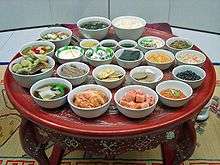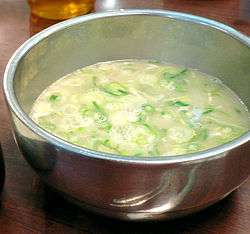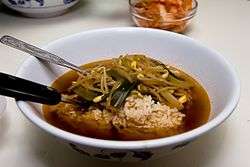Guk
|
Kongnamul guk with rice, bean sprout soup | |
| Alternative names | Tang |
|---|---|
| Type | Soup |
| Place of origin | Korea |
|
| |
| Guk | |
| Hangul | 국, 탕 |
|---|---|
| Hanja | 湯 |
| Revised Romanization | guk, tang |
| McCune–Reischauer | kuk, t'ang |
 |
| This article is part of a series on |
| Korean cuisine 한국 요리 조선 료리 |
|---|
|
Staples |
|
|
Guk (국, Korean pronunciation: [kuk]), also sometimes known as Tang (탕, Korean pronunciation: [tʰaŋ]), is a class of soup-like dishes in Korean cuisine. Guk and tang are commonly grouped together and regarded as the same type of dish, although guk is more watery and a basic dish for the Korean table setting, and is usually eaten at home; tang has less water than guk and has been developed for sale in restaurants.[1][2]
Overview
Guk is a native Korean word, while tang is a Sino-Korean word that originally meant "boiling". Tang has been used as an honorific term in place of guk. Tang can denote the same meaning as guk in the names of dishes such as mae-untang (spicy seafood soup), daegutang (codfish soup), samgyetang (ginseng chicken soup), or chueotang (추어탕).[1]
Generally, the names of soups made with vegetables are suffixed with guk rather than tang. Toranguk (taro soup), kimchiguk (kimchi soup), muguk (daikon soup), siraegiguk (soup made with napa cabbage), and miyeok guk (sea mustard soup) are some examples. Gamjaguk and gamjatang are made with different ingredients; gamjaguk is made largely with potatoes, but gamjatang is made with pork bones and few potatoes.[1]
Types
Guk is largely categorized into four groups of soups, such as malgeun jangguk (맑은 장국), gomguk (곰국), tojangguk (토장국), and naengguk (냉국). Malgeun jangguk literally means "clear (malgeun, 맑은) soup (guk, 국) seasoned with a condiment (jang, 장)," such as doenjang (soy bean paste) or ganjang, and is served in a bansang (반상, regular meal table). The main ingredients for malgeun jangguk are meat, fish, vegetables, and seafoods. Gomguk, also called gomtang, refers to either a soup type made by boiling various beef parts such as rib, oxtail, brisket, head, and so forth for a long time, or made with ox bone by the same method. The broth of gomguk tends to have a milky color and to be rich and hearty taste. It can also be made with chicken or pork bone, to produce samgyetang or gamjatang.
Tojangguk are based on doenjang broth and ssaltteumul (쌀뜨물, leftover water after washing rice for cooking). The taste is usually savory and deep. Naengguk are cold soups usually eaten in summer. These soups are usually clean and tangy, such as with oi naengguk (오이냉국, cold cucumber) and miyeok naengguk (미역냉국, cold wakame soup). Kkaetguk (깻국, sesame soup), made with chicken and sesame seeds, is thick and serves to replenish and supplement nutrients during hot weather.
Malgeun jangguk

- Tteokguk (떡국), tteok (rice cake) soup[3]
- Miyeok guk (미역국), wakame (edible seaweed) soup[4]
- Kongnamul guk (콩나물국), made with kongnamul[5]
- Muguk (무국), made with daikon[6]
- Gamjaguk (감자국), made with potato[7]
- Toranguk (토란국), made with taro[8]
- Bugeoguk (북어국), made with dried Alaska pollock[9]
- Bogeoguk (복어국), made with puffer fish[10]
- Jogaeguk (조개국), made with shellfish[11]
- Jaecheopguk (재첩국), soup made with jaecheop (small clams, Corbicula fluminea) harvested in rivers of Gyeongsang-do[12]
Gomguk

- Beef
- Gomguk/gomtang (곰국/곰탕, Korean pronunciation: [koːmk͈uk, koːmtʰaŋ]):[13]
- Seolleongtang (설렁탕): ox leg bone soup simmered for more than 10 hours until the soup is milky-white.[17] Usually served in a bowl containing somyeon and pieces of beef. Sliced scallions and black pepper are used as condiments
- Galbitang (갈비탕), made with galbi or beef ribs[18]
- Yukgaejang (육개장), beef soup with red chili flakes, soy sauce and bean sprouts[19]
- Doganitang (도가니탕), soup from knuckles and bones[20]
- Chicken and pork
- Samgyetang (삼계탕), a soup made with Cornish game hens that are stuffed with ginseng, a hedysarum, glutinous rice, jujubes, garlic, and chestnuts; the soup is traditionally eaten in the summer[21]
- Gamjatang (감자탕, "potato stew"), a spicy soup made with pork spine, vegetables (especially potatoes), and hot peppers; the vertebrae are usually separated, and the dish is often served as a late night snack but may also be served for lunch or dinner[22]
- Dwaeji gukbap (돼지국밥), a representative regional hearty pork-parts soup with rice[23] of coastal Gyeongsang-do

Tojangguk
Tojangguk are eaten all year round. The term emerged in the 1930s in Korean cookbooks.[24]
- Sigeumchi tojangguk (시금치토장국), made with spinach[25]
- Auk tojangguk (아욱토장국), made with malva[26]
- Naengi tojangguk (냉이토장국), made with horseradish[27]
- Ugeojiguk (우거지국), made with ugeoji (우거지, dried napa cabbage)[28]
- Daseulgiguk (다슬기국), made with freshwater snails (다슬기, Semisulcospira libertina)[29]
Naengguk
Naengguk refers to all kinds of cold soups, mainly eaten in summer. They are also called changuk (literally "cold soup") in pure Korean while the term naengguk is a combination of a Hanja word and a pure Korean word with the same meaning.[30] The first historical record on naengguk appears in a poem written by Yi Gyu-bo (1168–1241), a high officer of the Goryeo period (918–1392). Naengguk is referred to as "sungaeng" in the poem, which literally means sunchaeguk, soup made with sunchae (Brasenia schreberi). Yi praised its clear and plain taste.[31][32]
Naengguk is generally divided into two categories according to taste and ingredients. One group of naengguk is made by mixing chilled water and vinegar to give a sweet and sour taste; examples include miyeok naengguk made with wakame, oi naengguk made with cucumber, pa naengguk made with spring onions, nameul naengguk made with garlic, and gim naengguk made with gim or nori. The other group is made to supplement health and has rich tastes, such as chilled soup made with chicken, sesame, or soy bean.[31][32]
- Miyeok naengguk (미역냉국), cold wakame soup[33]
- Oi naengguk (오이냉국), cold cucumber soup[34]
- Kkaetguk (깻국), hearty cold soup made with chicken and ground sesame seeds[35]
- Naengkongguk (냉콩국), made with ground soybeans[36] and can be used for kongguksu
- Kongnamul naengguk (콩나물냉국), made with kongnamul
Ingredients
- Maeuntang (매운탕): a refreshing, hot and spicy fish soup.
- Haejangguk (해장국): a favorite hangover cure consisting usually of meaty pork spine, ugeoji (우거지 dried napa cabbage) coagulated ox blood (similar to blood pudding), and vegetables in a hearty beef broth; legend has it that soon after World War II, the restaurant that invented this stew was the only place open in the Jongno district when the curfew at the time lifted at 4:00 AM
- Haemultang (해물탕): made with various seafood
- Haemuljaptang (해물잡탕), made with seafood and beef offal, once part of the Korean royal court cuisine
- Altang (알탕): can be made with myeongran jeot (명란젓), salted and fermented Alaska pollack's roe seasoned with chili pepper or fresh roe
- Chueotang (추어탕): made with Misgurnus mizolepis[37]
- Yongbongtang (용봉탕): made with chicken, carp and softshell turtle[38]
- Manduguk (만두국): mandu soup[39]
- Wanjatang (완자탕): made with wanja (meatball-like jeon)[40]
- Gyerantang (계란탕): soup made with eggs[41]
- Ssukkuk (쑥국): made with ssuk (Artemisia princeps var. orientalis)[42]
- Sundaeguk (순대국): made with Sundae (or pork blood sausage) and sometimes it includes fatty pieces of intestine (gopchang), liver, lungs, bits of cartilage, and meat.[43]
Gukbap
Gukbap (국밥, Korean pronunciation: [kukp͈ap]) are dishes developed from guk. The term literally means "soup with rice." The dish is typically served in restaurants, and has become popular among the working class since the late Joseon Dynasty.[44]
- Kongnamul gukbap (콩나물국밥), clear soybean sprout (kongnamul) soup with rice
- Ttaro gukbap (따로국밥), a variety of yukgaejang, local specialty of Daegu[45]
The Japanese word for gukbap is クッパ kuppa. Video game designer Shigeru Miyamoto lent the word to the name of the character Bowser Koopa (大魔王クッパ Daimaō Kuppa in Japanese) in the Mario series of video games. Alternative names ユッケ Yukke (yukhoe) and ビビンバ Bibinba (bibimbap) were also considered, as Miyamoto had intended to name him after a dish in Korean cuisine.[46]
See also
References
- 1 2 3 최용기 (2008-02-25). "Guk and Tang ('국'과 '탕')" (in Korean). Official site of the Seoul Metropolitan Government. Retrieved 2008-05-26.
- ↑ Naomi Imatome-Yun (2010-12-10). "Guk and tang". About.com. Retrieved 2 April 2013.
- ↑ "Lunar New Years Tteokguk". The Korea Times. 2009-01-22. Retrieved 2013-04-02.
- ↑ "Miyeok-guk". Life in Korea. Retrieved 2013-04-02.
- ↑ "Kongnamul-guk". Life in Korea. Retrieved 2013-04-02.
- ↑ 무국 (in Korean). Encyclopedia of National and Ethnic Cultures. Retrieved 2013-04-02.
- ↑ 감자국 (in Korean). Encyclopedia of National and Ethnic Cultures. Retrieved 2013-04-02.
- ↑ "Toranguk Taro Soup". Encyclopedia of Korean Seasonal Customs. Retrieved 2013-04-02.
- ↑ "Bugeo-guk". Life in Korea. Retrieved 2013-04-02.
- ↑ 복어국, 먹을까 말까… 18세기 선비들의 논란 (in Korean). munhwa.com. 2012-05-21. Retrieved 2013-04-02.
- ↑ 맑은 조개국 (in Korean). Chosun. Retrieved 2013-04-02.
- ↑ 재첩국 (in Korean). Encyclopedia of National and Ethnic Cultures. Retrieved 2013-04-02.
- ↑ Korean Food | Gomtang | Stew Meat & Tripe Soup
- ↑ 사골곰탕 (in Korean). Chosun. Retrieved 2013-04-02.
- ↑ 엠파스 백과사전
- ↑ "사골곰탕 VS 꼬리곰탕, 최고 보양식은?" (in Korean). The Daily News. 2013-02-26. Retrieved 2013-04-02.
- ↑ "Food map: Eat your way around Korea". CNN Travel. 2012-04-06. Retrieved 2013-04-02.
- ↑ "Galbi Tang (Short Rib Soup) Recipe". About.com. Retrieved 2013-04-02.
- ↑ "YOOK-GAE-JANG". Trifood.com. Retrieved 2013-04-02.
- ↑ "Dogani-tang". Life in Korea. Retrieved 2013-04-02.
- ↑ "SAM-GYE-TANG". Trifood.com. Retrieved 2013-04-02.
- ↑ "5 Korean ways to eat a pig". CNNGo. 2011-11-11. Retrieved 2013-04-02.
- ↑ "Busan: Larger than Life". enewsworld. 2011-09-26. Retrieved 2013-04-02.
- ↑ 엠파스 백과사전
- ↑ 시금치토장국 (in Korean). Donga. Retrieved 2013-04-02.
- ↑ 아욱토장국(아욱국) (in Korean). RDA. Retrieved 2013-04-02.
- ↑ Paik Jae-eun (Professor of Food and Nutrition, Bucheon University) (2008). "Soup (Guk) An Essential Part of the Korean Meal". Koreana. Retrieved 2013-04-02.
- ↑ "Haejangguk". Hannaone. Retrieved 2013-04-02.
- ↑ 다슬기국(고둥국) (in Korean). RDA. Retrieved 2013-04-02.
- ↑ 냉국 (in Korean). Nate Korean Dictionary. Retrieved 2009-10-23.
- 1 2 냉국 (in Korean). Nate / Encyclopedia of Korean Culture. Retrieved 2009-10-23.
- 1 2 냉국 (in Korean). Doosan Encyclopedia. Retrieved 2009-10-23.
- ↑ "Miyeok naengguk". HannaOne. Retrieved 2013-04-02.
- ↑ 오이냉국 (in Korean). Chosun. Retrieved 2013-04-02.
- ↑ "Kkaetguk". HannaOne. Retrieved 3 April 2013.
- ↑ "Quelques plats de Gyeonggi-do" (in French). Korea Tourism Organisation. Retrieved 3 April 2013.
- ↑ "네이트". Retrieved 29 November 2014.
- ↑ "네이트". Retrieved 29 November 2014.
- ↑ "네이트". Retrieved 29 November 2014.
- ↑ "네이트". Retrieved 29 November 2014.
- ↑ "네이트". Retrieved 29 November 2014.
- ↑ "네이트". Retrieved 29 November 2014.
- ↑ Jung, Alex "5 Korean ways to eat a pig" CNN Go. 11 November 2011. Retrieved 2012-04-11
- ↑ 엠파스 백과사전
- ↑ 엠파스 백과사전
- ↑ Deezer. "Mario in Japan page at The Mushroom Kingdom". Retrieved 29 November 2014.
Further reading
- "Guk (국)" (in Korean). Empas / EncyKorea. Retrieved 2008-05-27.
- "Guk (국)" (in Korean). Doosan Encyclopedia. Retrieved 2008-05-27.
External links
- Soups and stews from Food in Korea
